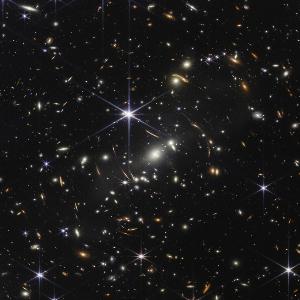Modern cosmological observations seem to demand three mysterious, poorly understood ingredients in the standard model of cosmology: We need an as of yet undetermined mechanism of cosmic inflation in order to explain the Universe's initial conditions. We need a completely new (and strange) matter component to explain the observed gravitational collapse of large scale density fluctuations and we need a completely new (and even more strange) energy component to explain the cosmic expansion history.
The field of large-scale structure (LSS) cosmology, which studies the statistical properties and the time evolution of large-scale dark matter density fluctuations and of the luminous matter that traces these fluctuations, is one of the most promising subjects to work out more information about these three frontiers of modern physics.
So far, the mode of most of LSS cosmology was the following: consider different cosmic density fields - i.e. the galaxy density field or the field of cosmological gravitational lensing (cosmic shear) which directly traces matter density - and measure the variance of the fluctuations of these fields as a function of smoothing scale and time. These variances - or rather the equivalent 2-point correlation functions of these fields - are then compared to predictions of the cosmological standard model. A severe obstacle to the 2-point function program is the fact that we can only observe one Universe. This means that we cannot arbitrarily increase the information content obtained from 2-point statistics by simply “observing for longer”. It is the current consensus in the LSS community (and we agree with that consensus), that even with upcoming all-sky galaxy surveys like Euclid and LSST standard analysis techniques will not yield conclusive information about the three above mentioned mysteries.
This is why we need to understand cosmic density fields beyond their variances. The ACAI Chair is at the forefront of this development. Through both theoretical work and analyses with observational data we have contributed to and lead the development of non-standard techniques like density split statistics (Gruen, Friedrich et al. 2016; Friedrich, Gruen et al. 2018; Gruen, Friedrich et al. 2018; Burger, Friedrich et al. 2022; Burger, Friedrich et al. 2023), shear peak statistics (Kacprzak, Kirk, Friedrich et al. 2016), higher-order correlation functions of cosmic shear (Halder, Friedrich et al. 2021), higher order moments of cosmic density fields (Gatti, Chang, Friedrich et al. 2020) and analyses of the full shape of the probability density function (PDF) of cosmic density fluctuations (Friedrich et al. 2020; Uhlemann, Friedrich et al. 2020; Boyle, Uhlemann, Friedrich et al 2021; Friedrich et al. 2022; Uhlemann, Friedrich et al. 2023).
To coordinate our efforts in modelling and analysing the full distribution function of cosmic density fluctuations we have recently founded the PANAMO collaboration (Paris-Newcastle-Munich-One point collaboration). DFG is going to fund research visits and a dedicated workshop within PANAMO over the year of 2024.


